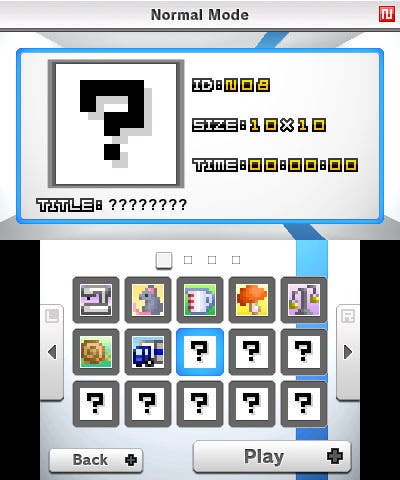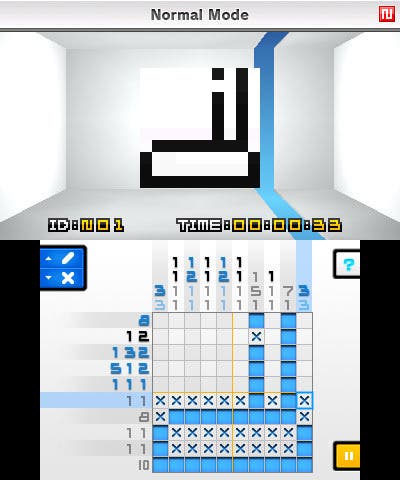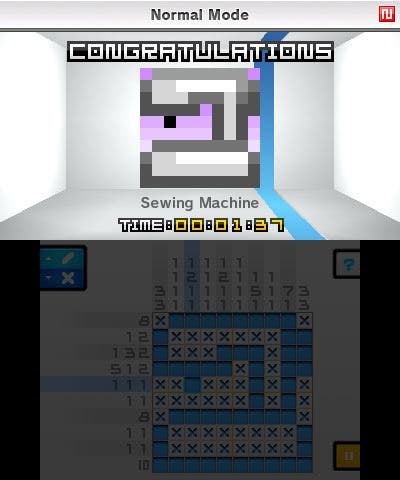Picross E Review
Pixel (nearly) perfect.
It was with an overwhelming sense of nostalgia that I met the first few levels of the 3DS eShop release Picross E. Bizarrely, this wasn't nostalgia for the original Mario's Picross on Game Boy, which it most closely resembles, but for those glory days of the original DS; those days when Hudson Soft and others were releasing (albeit only in Japan) a series of some of the finest, most perfectly presented puzzles ever seen in gaming form.
As I held my 3DS I felt a sense of sadness for those lost times, wondering where the new incarnations of Slitherlink, Pic Pic, Picross 3D and Illust Logic DS + Colorful Logic are. Why is this new handheld, with its slight smattering of platformers and RPGs, so bereft of that gorgeous variety?
Picross E clearly demonstrates that the machine is perfect for it - and, oh my goodness, so perfect surely for a sequel to HAL Laboratory's Picross 3D. So perhaps this is the start of a new golden age? Let's hope so, because Picross E is splendid.

Presumably most of you are familiar with the puzzles now, especially given the confusing popularity of the mediocre Picross DS. You have a grid, here either 10x10 or 15x15, and numbers at the edge of each row and column indicate how many squares should be filled in. Deduce which they should be via the few-but-engaging techniques, and you create a picture! Hurrah! Picross E does that, precisely that, and absolutely nothing else.
And that's enough - especially at a significantly lower price than you'd usually expect for a full Nintendo game. For £4.50, rather than £30, you get 150 Picross puzzles, and you get them implemented superbly. Picross E is not bulked up with frills and extras, but what's crucial is that the core puzzles are so flawlessly delivered. And if you were one of the many who enjoyed Picross DS, then it is with delight that I welcome you to the concept done properly.
Picross DS' huge fault was the way it insisted on zooming in on the puzzles, thus rendering just about every method by which they're completed 17 times as frustrating. Not being able to interact with the full puzzle at any time was a bewildering decision, and one that's not repeated here. Instead, everything is just right.
Picross E really is incredibly similar to 1995's Mario's Picross (which is also on the eShop), right down to that silly roulette hint option that fills in a row and column for you at the start if you need the help. Sadly, again like its spiritual great grandfather, it doesn't have an option to just make the request go away, meaning you have to say "no" for each and every puzzle.

Once started, if you've filled in all the right squares for a row and want to X out the rest, you just select the Xs and slide the stylus over the whole row - it smartly knows you don't want to overwrite anything, and for the most part it also smartly prevents you slipping into adjacent rows. The same is true in reverse. The top screen shows the image you're creating, here rather cutely slowly developing colour as you progress. And the bottom screen has the absolute bare minimum on display besides the grid, with the necessary buttons exactly where your fingers might want them.
There are three ways to fill things in, letting you opt for your favoured style. If you're a hardcore old-timer, you can choose to have it all on the face buttons, Mario's Picross style. If you prefer the stylus, you can choose between tapping to enter either blocks or Xs, or you can have it default to neither and instead choose by pushing up or down on the slider or d-pad. That last one is the best for me, and the spongy analogue controller proves a lovely smooth method for switching back and forth to allow super-speedy filling.
The one feature I've not seen in other Picross games is one called "Navigation". This is an optional hint system that makes the numbers at the top and side become super-smart. They glow blue if anything in that line is currently possible to fill in, and fade to a duller blue if there are Xs you could put in there. When there's nothing you could logically fathom there, they turn to a bold black, and fade to a lighter grey when everything in that line is complete.

This means the game understands every single trick there is for solving these puzzles, and knows where any of them can be applied. Leaving it on all the time would, I think, make the already slightly low difficulty level far too easy - but when you're just flat-out stuck, tapping it on lets you see where you've missed something but, crucially, not what it is that you've missed. It's a lovely prompt. And for those who do fancy letting it make things easier throughout, every now and then the game will just say, "Nope, you're doing this one on your own."
The division of the puzzles is slightly odd. 60 are set as "Normal Mode", where filling in a wrong box incurs a time penalty (although here the timer counts upward, rather ruining the point of this feature from the Game Boy original). In "Free Mode" puzzles, it doesn't. Half of each section's puzzles are 10x10 grids, the other half 15x15, while there are another 15 Easy puzzles and, oddly, 15 "Extra" puzzles. These are, in fact, far harder ones, and are a welcome way to end a game that a Picross aficionado will likely race through.
It's a bit of a shame the game doesn't seem to notice when you've solved all the puzzles in a section, and it's a bigger shame that there aren't any of the star ratings familiar from the late Hudson Soft's takes on these games. The incentive to replay to beat your time is pretty low when there's no recognisable reward for doing so.
There is a lot that could still be added to Picross E to raise it to the levels of those sublime puzzlers from the last decade. But as it is, it delivers the essential basics pretty much perfectly, and it's hard to complain much about that.
Could Picross E's publisher Jupiter perhaps be setting itself up to be the Hudson for the 3DS? Good grief, I hope so. If so, this was a splendid way to start.

